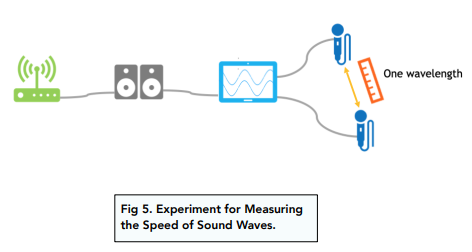Measuring the Speed: Sound Waves (GCSE Physics)
Measuring the Speed: Sound Waves
Measuring Speed of Sound Waves
Now that we know the formula to find wave speed, we can apply this to real life situations. For exams, you need to know how to measure sound waves in air.
Method
- Gather all the equipment. For this experiment, you’ll need two microphones, an oscilloscope, a loudspeaker and a signal generator.
- Set up the equipment. Attach the loudspeaker to the signal generator. Note down the frequency of the signal generator. Attach each microphone to the oscilloscope in order to see the trace of the wave on the screen.
- Separate the microphones. Move the microphones so that they appear as two separate waves on the oscilloscope.
- Align the wavelengths. Now, move one microphone away from the other very slowly. Whilst doing this, you should look at the oscilloscope screen. As you move the microphone, the wavelengths on the screen will align with each other. You should move the microphone until the wavelengths have moved exactly one wavelength apart.
- Measure the distance. Now that you can see that the waves have moved exactly one wavelength apart, you should measure the distance in between the microphones. This is the length of one wavelength.
- Use the formula. Now we have measurements of wavelength and frequency, we can use the formula for wave speed.


Sound waves are a type of energy that travels through the air or any other medium as a vibration. They are created by a source that vibrates, such as a speaker or a musical instrument, and move through the medium to reach our ears, where they are heard as sound.
The speed of sound waves can be measured by timing how long it takes for the sound waves to travel a known distance through a medium. This can be done by using equipment such as a stopwatch, ruler, or sonic ranger.
The speed of sound waves can be affected by several factors, including the temperature, pressure, and density of the medium through which they are traveling. The speed of sound is faster in solids and liquids than in gases, and it increases with temperature and decreases with pressure.
The speed of sound in air is approximately 340 meters per second, or 1,230 kilometers per hour. However, this can vary slightly depending on the temperature, pressure, and other factors.
The speed of sound is used in many everyday applications, including sonar and echolocation, weather forecasting, and medical imaging. By measuring the time it takes for sound waves to travel a certain distance, scientists and engineers can gather information about the environment and make important decisions.
Sonar is a technology that uses sound waves to detect and locate objects underwater. It works by sending out a sound wave and measuring the time it takes for the wave to bounce back after hitting an object. This information can be used to determine the distance and location of the object.
Weather forecasters use the speed of sound to gather information about the atmosphere. By measuring the time it takes for sound waves to travel through the atmosphere, they can gather data about temperature, pressure, and other important weather variables.
What is medical imaging and how does it use the speed of sound? A: Medical imaging is a type of medical technology that uses sound waves to create images of the inside of the body. This is done by sending sound waves into the body and measuring the time it takes for the waves to bounce back after hitting internal structures. The information gathered is then used to create images of the body’s organs and tissues.
The speed of sound is important in the design of musical instruments because it affects the pitch and tone of the sound that is produced. Instruments that produce higher pitched sounds, such as flutes, typically have a faster speed of sound, while instruments that produce lower pitched sounds, such as drums, have a slower speed of sound. By understanding the speed of sound, instrument makers can design instruments that produce the desired sound.





Still got a question? Leave a comment
Leave a comment